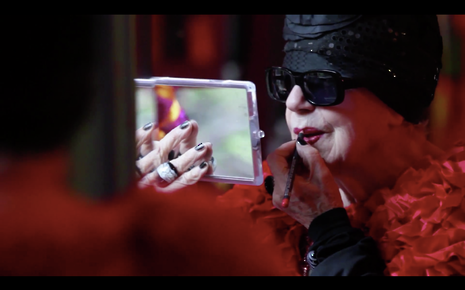Ageless style
Flora Walsh thinks about how the fashion world depicts old women when longevity becomes the norm

The difficulties faced by the silver segment of the population (deemed those over 55 by BCG) may not be the most pressing issue for an undergraduate. Old age seems so far away, and is becoming ever more distant thanks to improved medicine and quality of life. Society dictates that ageing involves only negative experiences and is a phase in life not to look forward to. However, as the quality of our twilight years is ever improving, there is no reason why we cannot be active, healthy and, dare I say it, stylish in our 60s, 70s and 80s. We are living longer and increasingly wealth is focused in the older portion of the population. So, how has fashion adapted to meet this changing demographic environment and how will it continue to evolve?
This topic is particularly provocative from the female perspective. Whereas men are deemed to improve with age, like vintage wine, age depreciates the social tropes of female attractiveness more conspicuously. This stems from the tension between the traditional concept of feminine beauty and the biological reality of the body. Women’s fertility, in essence, ‘expires’ to a certain extent, and their aesthetic relevance is extinguished with it.
However, as the fashion world has had to adapt to the fact that we are living longer, there appears to be a seismic shift blossoming in the way we considered the ‘payoff’ between beauty and age. A study conducted by Abbey, the building society and mortgage lender, found that, in the UK, 34 per cent of the over-50s population accounts for nearly 75 per cent of the country’s total wealth. This trend is mimicked across the developed world. So, the key to the longevity of the fashion industry in this turbulent economic period lies in, well, the increasing longevity of the population.
For the past few years, Selfridges has marked the beginning of a new year with the ‘Bright Young Things’ campaign, where 14 up-and-coming young designers are commissioned to create an individual window display. In 2015, however, the department store ushered in the start of the year with an initiative dubbed ‘Bright Old Things’, which will highlight the likes of Molly Parkin, then aged 82, previous fashion editor of The Sunday Times; actor and painter William Forbes-Hamilton, 82; and designer Nick Wooster, 55.
The leading American writer on moral and cultural chaos, Joan Didion, was chosen as the face of Céline for SS15, alongside French ballet dancer and choreographer Marie-Agnès Gillot and British model Freya Lawrence. The brand is known for being achingly cool, so their celebration of beauty, style and age has heralded a new appreciation of the older woman. The definition of graceful ageing, Didion (born in 1934) was photographed by Juergen Teller sporting a pair of sunglasses from the brand’s iconic collection. She also acted as the inspiration for Céline’s resort Campaign, where the model Daria Werbowy is depicted leaning out of the window of a Corvette Stingray, echoing a portrait of Didion in Life magazine.
Another high fashion house that has extolled the grace and reverence of growing older has been Lanvin. For their AW12 campaign they used ‘real-life’ models over the age of 60, including 62-year-old Tziporah Salamon and 82-year-old Jacqueline Murdock. Both women were discovered on the popular street-style blog Advanced Style, which was created by Ari Seth Cohen to celebrate the street style of older women and men. She is determined to show that people over a certain age can be just as relevant and creative as the fresh faces on the fashion scene, and the affirmation of a revered house such as Lanvin proves her point.
One of the greatest misconceptions about ageing consumers is their discomfort in digital channels and unwillingness to engage online. In a study conducted by AT Kearney, it was found that, up until the age of 75, people were comfortable in using the internet. In developing markets like Nigeria and Brazil and generally across the board Internet usage is pretty much even up until 75. Tapping into this technologically minded portion of the over-65 age group could unlock the potential for massive growth in fashion, where online shopping outlets are leading the sales figures.
Once the fashion world comes to embrace age, rather than attempting to avoid it for as long as possible, there will be unlimited opportunity retailers to engage with older consumers in a way that reflects their style and aspirations, rather than the stereotypes that come with age. For my part, I don’t want to be considered a superfluous part of fashion’s target market when my hair turns grey; rather, my age and experience should enable me to draw upon more sources of inspiration for my style than when I was younger. As Mark Twain once said: “Age is an issue of mind over matter. If you don’t mind, it doesn’t matter.”
 News / Eight Cambridge researchers awarded €17m in ERC research grants27 December 2025
News / Eight Cambridge researchers awarded €17m in ERC research grants27 December 2025 News / Clare Hall spent over £500k opposing busway 24 December 2025
News / Clare Hall spent over £500k opposing busway 24 December 2025 Comment / League tables do more harm than good26 December 2025
Comment / League tables do more harm than good26 December 2025 Comment / The ‘class’ of Cambridge24 December 2025
Comment / The ‘class’ of Cambridge24 December 2025 News / Caius mourns its tree-mendous loss23 December 2025
News / Caius mourns its tree-mendous loss23 December 2025








